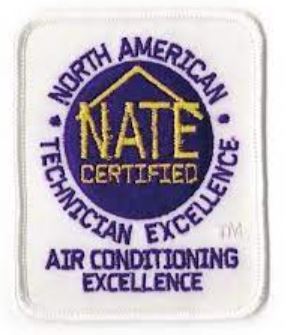The nation’s premier organization for helping HVACR technicians reach their professional milestones has reached a milestone of its own.
North American Technician Excellence, better known as NATE, is marking its 25th anniversary this year. A nonprofit founded with support from industry leaders who were looking to raise professional standards, NATE was organized in February 1997 and administered its first nationwide tests later that year.
Based in Arlington, Virginia, NATE offers testing and certifications in more than a dozen HVACR specialties, from air conditioning to heat-pump installation to efficiency analysis. In recent years, NATE added training to the services it provides; its partnership with Interplay Learning, the NATE Training Academy, which launched this year, is an education platform that helps technicians prepare for exams online and at their own pace.
‘Best Foot Forward’
“We are all about making sure that technicians are highly confident and highly competent, because as we all know they are really the face of that contractor” and by extension the HVACR industry, NATE COO John Lanier said recently. “We want to do our part to make sure those technicians put our best foot forward.”

LOOK FOR THE PATCH: NATE has certified nearly 35,000 HVACR technicians in its 25 year-history. (Courtesy of NATE)
A recent NATE survey, Lanier said, found that 75% of contractors described their NATE-certified technicians as better prepared on the job.
“That leads to a better relationship with your customers,” he said.
“Having NATE certified technicians brings value in knowing they are committed to their job and helping our customers,” said Alyssa Angellotti, vice president of business development at Expert Heating & Cooling in Taylor, Michigan.
“Each individual has taken the time to study and prepare for the testing and really be knowledgeable when it comes to HVAC,” she added. Certifications help draw business, Angellotti said, because customers want the best.
Expert is a residential and commercial HVAC installation and servicing contractor with 12 full-time technicians as of mid-April, seven of whom were certified by NATE in different specialties. The company’s goal is to have all of its technicians certified by the end of the year, Angellotti said.
NATE’s tests are developed by its technical committee, made up of professionals from across the HVACR industry, including manufacturing and contracting. Nearly 35,000 technicians have been certified by NATE in its 25 years, many in more than one specialty.
“We make sure that our certifications stay up to date and are following very closely the amazing innovations that come out of this industry,” Lanier said.
Flexible Approach
A significant development in its history, said Lanier, came a few years back, when NATE’s approach to technician recertification was changed to better align with techs’ busy schedules. Instead of requiring 60 hours of continuing education, or re-testing, every five years, Lanier said, the standard is now 16 education hours every two years, and techs have internet accounts that make documenting training hours easy. (Re-testing every two years is also an option.)
The result, Lanier said, is that techs are documenting more education hours. About 89% of techs who recertify, he said, now do so through continuing education, and the rest through re-testing. When he started at NATE nearly nine years ago, Lanier said, the vast majority of recertifications were done through re-testing.
However, the drop in the number of techs taking recertification tests didn’t have much impact on NATE testing overall, Lanier said, as contractors and technicians have a growing interest in NATE. Certifications had been increasing every year until 2020, when the coronavirus pandemic struck, Lanier said, and the numbers more recently have begun returning to normal.
In 2020, NATE launched live online exam proctoring, giving test-takers the option of taking exams remotely with the use of a webcam and an internet connection. About 8% of NATE’s exams are now administered online, Lanier said.
NATE’s first president, Rex Boynton, said it wasn’t easy to get different parts of the industry — manufacturers, distributors, contractors, training organizations, and trade associations — on the same page to get NATE up and running. And technicians, some of whom Boynton shadowed in the field, needed to be convinced that their work wasn’t being questioned and that professional certification would be a bonus, he said.
“It was a struggle, to be honest with you, the first couple of years, but ultimately we got the right people on the bus with us and we just kept driving,” he said.
A big breakthrough, Boynton said, came in the year 2000, when the manufacturer Carrier decreed that contractors had to have a percentage of technicians certified in order to be eligible for factory-authorized dealer status.
“That really jump-started our widespread testing,” he said.
Boynton served as president from 1997 to 2010. He said it’s been gratifying to watch NATE’s evolution.
Looking to the Future
Gurminder Sidhu, NATE’s senior director of business operations, said NATE is working to expand its reach outside of North America, and that she sees its certifications becoming globally recognized, similar to Automotive Service Excellence (ASE) certifications, within the next 25 years.
“I believe it will evolve as the industry’s needs evolve,” Sidhu said. “If the manufacturers, wholesalers/distributors, contractors continue to support NATE, the possibilities are endless.”
Lanier said NATE’s goal is to remain “relevant, accessible, and convenient” for those in HVACR.
“This is an industry that is constantly innovating, constantly finding new ways to provide comfort in our homes and businesses, and NATE will be there every step of the way,” Lanier said.
“We work closely with contractors, distributors, manufacturers, and training providers to not only keep the HVACR community aware of our resources and how we can help them grow, but also learn more about their work and how we can respond to their needs,” he said later.



Report Abusive Comment